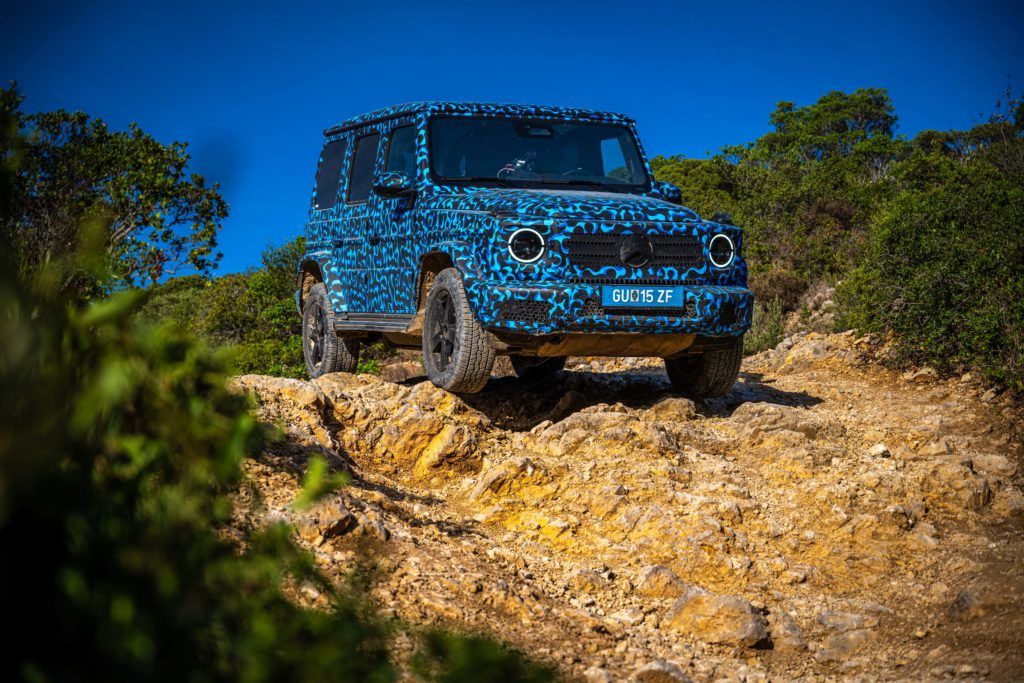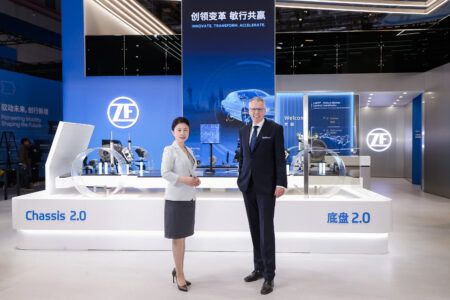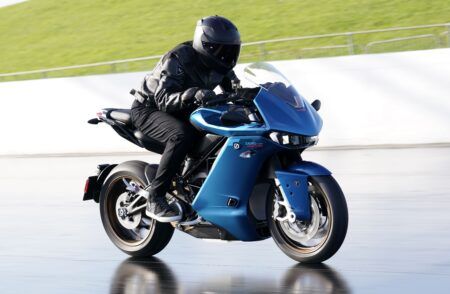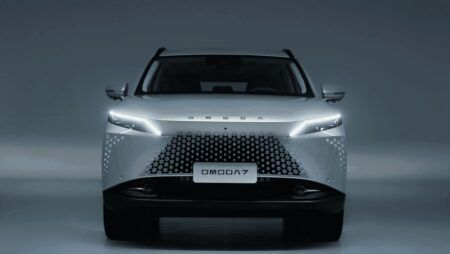Words Kyle Fortune
Mercedes Benz is set to reveal its production-spec electric G-Class EQG in 2024, reinforcing their commitment the electrification of its’ range. Before that, E&HVTI get a first look as we go along for the ride while engineers test the prototype off-road.
Fabian Schossau, Chief Engineer Vehicle and eDrive G-Class at Mercedes-Benz G GmbH, is finding it difficult to hide his enthusiasm as we drive around Circuit Du Lastours, in France. It’s a favourite testing spot for many rally raid teams, such are the extremes its terrain offers and it’s where Mercedes-Benz launched the current generation of G-Class. The route we’re climbing and descending on is a precipitous track around a vineyard, atop which there’s a flatter section where higher speed off-road driving is also possible.
Schossau laughs when I point to the occasional circles marked in the terrain, which revealing as much about the G-Class we’re in today as the wind turbines that also punctate the scenery. E&HVTI is in the passenger seat of an early prototype EQG today, Mercedes-Benz’s electric version of its G-Class, the disguise it’s wearing doing little to hide its familiar boxy proportions. Those dusty circles are evidence of the EQG’s party trick, and the wind turbines could power the batteries and four individual wheel electric motors that allow it, the EQG’s ‘G-Turn’ enabling the EQG prototype to rotate completely within its own length like a tracked vehicle. That’s something Schossau admits is only for off-road use, and an enjoyable and potentially useful quirk of its four electric motor propulsion, before he adds there’ll be more innovations from the driveline. What they are Schossau isn’t yet prepared to discuss, saving those details until nearer the production car’s 2024 launch date.
Mercedes-Benz has been bullish in its corporate stance in relation to the electrification of its model range, and there’s arguably no better a demonstration of that commitment than the company electrifying one of its most iconic vehicles. The G-Class exists as its own distinct line within the business, based in Graz, Austria, it’s essentially a sub-brand, or, as Emmerich Schiller, CEO of Mercedes-Benz’s G-Class, describes it: “a company within a company.” The G-Class’s off-road ability is legendary, it a point of company pride that to wear the G-Class badge the car must be able to undertake the gruelling 5.6km test route up Graz’s Schöckl mountain. That terrain is brutal, featuring gradients of up to 60% and side slopes of 40%. Few owners will ever need its capability, but it’s not a proper G-Class without being ‘Schöckl Proved’.
That presented a problem when the concept of an EQG was first discussed, admits Schiller, because to be an authentic G-Class, there had to be no compromises in its off-road ability, regardless of what’s powering it. He says: “I was thinking could we achieve it, just doing a car that looks like a G-Class, that is clearly feasible, but building a car that has no compromises in off-road and on-road capabilities, and to make it in time and to a budget that’s achievable? That’s a headache project.”
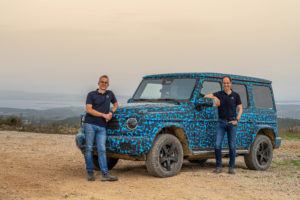
Good for torque
Mercedes-Benz could have taken that easy option and created an electrically powered pastiche of the G-Class, but such is the regard for the badge and what it stands for, and the need to pass the Schöckl test, Schiller’s headache became a reality. That requirement for it to be a proper off-roader rather than an SUV has dictated its technical make-up, Schiller saying: “We in the inner team were pretty clear from the beginning that we wanted to go the four motor route, we had discussions about other combinations, whether we couldthe fuirst make some synergies by using 3 or 2 motors as there are some Mercedes-Benz models with two on the rear and one on the front, others with one on each axle, but we decided to go with four. We could have saved money, we could have used those synergies, but our approach was if we make the G-Class electrified we do not want to compromise in any of its off-road ability. With this as a target, then it’s clear that you must go with the four motors. The downside is it’s so complicated, from the software behind, and everything, that it is more challenging.”
Challenging, certainly, but not the first time Mercedes-Benz, or more correctly Mercedes-AMG has built such a model, the SLS Electric drive, of which around seven were built, featured electric motors powering each wheel. That previous proof of concept undoubtedly helped, but with the EQG being a series production model and one that has a far wider remit, the testing is, necessarily, more extensive. Schiller explains: “the biggest challenge is the software, just for the E Drive system it’s many thousands of requirements and every requirement has thousands of lines of code. You really must set up a testing procedure so you really test different combinations, it’s a routine where we take this feature versus that one, this ground versus that one, because the worst thing that could happen is you have these four motors and just imagine if one of them turned on highspeed, it would be a nightmare.”
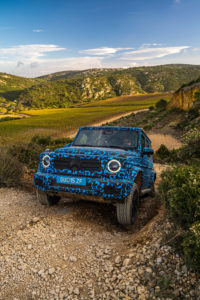
Electrifying an icon
The timeline hasn’t helped that process, Schiller’s team has faced a compressed development time for the EQG, the difficulties compounded, not just because of the four motors, but also the requirement for the batteries to fit within the separate ladder chassis frame, as well as ensuring all the electrical components would survive the harsh conditions that being situated in the G-Class would place upon them. The batteries require some of the ladder sections of the frame to be removed, their housing becoming a structural element in the frame, with both the engineers saying making the housing a stressed member is difficult, particularly in relation in sealing to prevent water and dust ingress in extreme situations.
Like the combustion engine G-Class that frame is linked to the body via eight mounting points, Schiller admitting the inherent stiffness of the G’s body has meant no additional strengthening or sound deadening has been required for the EQG, with the only sounds coming from it, at any time during our ride-along, being of the tyres on the terrain. That, and the shocking bang when Schiller deliberately drops the underside of the EQG on a rock to demonstrate the protection for the batteries underneath, these giving rock-sliding capability and protected by panels constructed of a carbon Kevlar mix that’s significantly lighter than one made from steel.
Schossau underlines that such extreme situations were considered in the early development phase of the EQG, similarly the necessity of the drivetrain featuring a low-ratio transfer case, stating: “you might drive in one situation where you have three wheels up in the air, and with one wheel for propulsion, and this is kind of like how we designed the torque requirement, the low range here is really good for torque.” The benefits of a low ratio transfer case, with one per individual motor are numerous, Schossau saying: “we decided that we wanted instant torque all the time, whenever and wherever we need it. We decided the fastest and best for manoeuvrability, is with a single wheel drive, and for the EDU [electronic drive unit] perspective it was also very important to get the low range in, because slow speed driving is very pushy for the invertor and for the electronics. The electronics needed a different gear ratio so we can have slower speeds for longer times without issues in relation to the cooling.”
Given the terrain the EQG is conquering with ease, at speeds barely more than you’d walk at, that’s significant, it apparent the EQG is having less trouble around the route than the combustion-engined G-Class that’s ahead with the photographer. Schiller is driving and making it look easy, saying: “we built in a feature where I don’t need to use the pedal, either for acceleration or braking, like a creep, both uphill and downhill. If I want to go a bit faster, I can use the steering wheel paddle.”

Hours not distance
What the cell technology, or battery capacity or motor outputs are, nobody’s prepared to say today, but Mercedes-Benz has already registered both the EQG 560 and EQG 580 model names, the team admitting that of course they’ll dip into the corporate parts bin for the final production model. Currently that would mean access to the 108kWh battery of the EQS SUV and EQS saloon, but with the EQG’s debut still at least a year away it’s likely that the EQG will feature new cell technology that Mercedes-Benz is known to be working on, that offering a potential increase in power density of around 20%. Expect the production car to have a minimum range of around 300km (186 miles), and, potentially more.
Any advantage here would obviously be beneficial, as Schiller does admit that the G’s iconic shape is far from the slippery EV norm. Here, off-road the team prefer to discuss hours, rather than distance, and Schiller says: “in this terrain I would say we could drive 15-16 hours,” and, certainly, the power percentage display barely moved in the hour or so we spent in the car, that underlining how efficiently the drivetrain is working, as well as underlining the considerable opportunity for regeneration during lengthy, steep descents. He won’t say how much heavier it is, but when I suggest it’ll weigh in the region of 20-30% more than a V8-powered G-Class the responses are a bit less evasive, which would suggest a gain of around 400-500kg, over the already bulky circa 2330kg of the G500 model.
That weight has no bearing on its off-road performance, which, bluntly, is extraordinary, the EQG prototype making light work of the heavy terrain. Schossau is quick to say, too, that while the EQG is necessarily heavy, it doesn’t feel it, to drive, with a lot of the development work presently in relation to the steering feel and weight, as well as finessing the various, driver selectable drive modes. Naturally, Schossau is keen to finish our test with that G-Turn, pressing the button and seeing the motors on each side of the EQG turn in opposite directions to have it rotate within its own length, that neat trick fun, but a clear demonstration that with the EQG its electrification, while certainly not easy, has created opportunity. Schossau says: “the point is, just copying what’s come before is not always the best, because you can always do more, seeing where you can put the propulsion, how to get the proper control, that is still the area where we’ve had to do the most brain work, and we’re pretty happy with how it goes now.”


